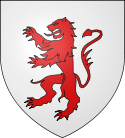- Armagnac (province)
-
This article is about the county in France. For other uses, see Armagnac.
The hilly countship of Armagnac (Gascon Armanhac), in the foothills of the Pyrenées between the Adour and Garonne rivers, is a historic countship of the Duchy of Gascony, established in 601 in Aquitaine (now France). It is a region in southwestern France that includes parts of the Departments of Gers, Landes, and Lot-et-Garonne.
The region is predominantly agricultural and is noted for its Armagnac brandy, the oldest French brandy.
Once an important countship, it reached its greatest power and extent during the 14th and 15th centuries.
Contents
History
Under Roman rule, Armagnac was included in the Civitas Ausciorum, or district of Auch, of Aquitania. Under the Merovingians it was part of the duchy of Aquitania. Near the end of the ninth century the part now known as Fezensac became a hereditary countship. In 960, Armagnac was separated from Fezensac as a separate county, under Bernard le Louche, Géraud Trancaléon and Bernard II, who reunited under his control all of Gascony (1040–1052); in 1052 Gascony became part of "Aquitania", by personal union of duke William VIII. About 1140 Bernard's grandson, Géraud III, briefly reunited the comté of Fezensac, which was then detached as an appanage for a younger son, styled comté de Fézensaguet. When Gascogne was linked once more to Aquitaine by the Treaty of Meaux in 1229, the county of Armagnac was the most powerful of the fiefs of Gascony. The chance of dynastic succession continued repeatedly to separate Fezensac.[1]
The three great territorial lords in the south were the Count of Armagnac, the Count of Foix, and the Lord of Albret. The counts of Armagnac increased their territory through marriage and purchase. Jean I, comte d'Armagnac (1319–1373) and his successors joined to Armagnac the comté of Rodez and that of Carlat, and the vicomtés of Lomagne and Auvillars, Comminges and briefly Charolais (which Jean III alienated in 1390).
During the Hundred Years' War the southern part of France, including Armagnac, was ceded to England by the Treaty of Bretigny (1360). Edward, the Black Prince, administered the region for his father, King Edward III of England. He soon alienated the nobles by giving privileges to the towns and levying heavy taxes. Until this time Armagnac had remained practically independent by shifting alliances, but the rule of the Black Prince was so harsh that the count of Armagnac appealed to the French king for help in 1369. By submitting themselves to King Charles V of France, noble families like the Armagnacs were able to retain much of their former power and assure themselves of protection.
In 1410 the daughter of Count Bernard VII of Armagnac (d. 1418) was married to Duke Charles I of Orleans. Charles' father had been killed by supporters of the duke of Burgundy, who resented Orleans' influence on the king. After the marriage, the Armagnac family became associated with the part of King Charles VI against Burgundy, and the royal faction came to be called Armagnacs. Until his death in 1418, Count Bernard remained a bitter enemy of Burgundy. When Burgundy allied itself with England during the later stages of the Hundred Years' War, the friction between the two parties greatly increased. The two factions engaged in a bloody civil war that ended in 1435.
After peace was established, many veterans originally recruited by Count Bernard VII formed mercenary bands that also became known as the Armagnacs. Although they were in the service of King Charles VII, the Armagnacs became notorious for their rapacious plundering in the north of France. In 1444 they were sent to Switzerland on an expedition known as the Armagnac War, which culminated in a battle between the Swiss and the Armagnac mercenaries on August 26, 1444. Although the Swiss were badly defeated, their determined resistance persuaded the Armagnacs to withdraw from Switzerland. Soon after, the Armagnacs were incorporated into Charles VII's regular army.
After the death of Bernard VII in 1418, the counts of Armagnac gradually lost their powerful position in southern France. In the late fifteenth century Count Jean V opposed King Louis XI. He was driven from the Armagnac lands and was killed by the king's soldiers in 1473. After the last court died in 1497, Armagnac was united temporarily with the crown. However, King Francis I gave the district to a nephew of the last count, and it subsequently passed by marriage to the family of Henry of Navarre. Henry became king of France as Henry IV in 1589 and joined Armagnac to the royal domain in 1607.
In 1645, Louis XIV granted the title to Henri de Lorraine-Harcourt, whose heirs possessed it until the Revolution.
Today the region is associated with the production of Armagnac, one of the world's great brandies. It is also renowned for its manufacture of foie gras.
Geography
The region is watered by several small rivers that descend from the Lannemezan plateau; the Gers River is the largest of these.
See also
Notes
- ^ The elder branch of the Armagnac line failed to produce a male heir in 1245, so that the two lines were rejoined in the person of Géraud V, comte de Fezansaguet, confirmed as comte d'Armagnac in 1256; however, at his death (1285) the two counties were separated anew.
Bibliography
- The Encyclopedia Americana, 1977
External links
- Stories about the region (in French)
Categories:- Former provinces of France
- Counts of Armagnac
Wikimedia Foundation. 2010.


